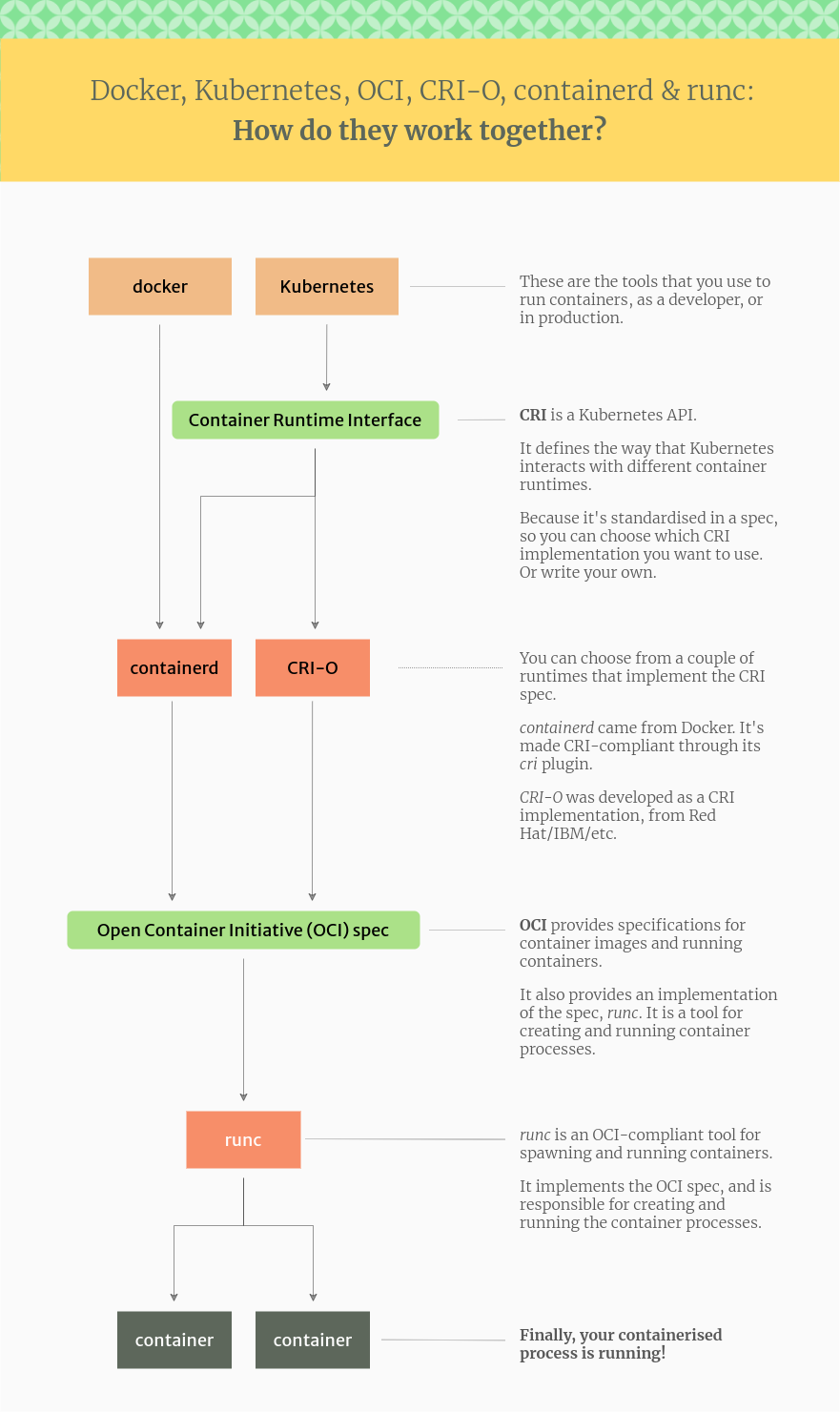Containerd

What is Containerd
Containerd is a high-level container runtime that came from Docker, and implements the CRI spec. It pulls images from registries, manages them and then hands over to a lower-level runtime, which actually creates and runs the container processes. Another area that has been added to containerd over the past few months is a complete storage and distribution system that supports both OCI and Docker image formats. You have a complete content addressed storage system across the containerd API that works not only for images but also metadata, checkpoints, and arbitrary data attached to containers.
Explaining Container Ecosystem
The container ecosystem is made up of lots of exciting tech, plenty of jargon, and big companies fighting each other. The main standards to be aware of (although you don’t need to know all the detail) are:
the Kubernetes Container Runtime Interface (CRI), which defines an API between Kubernetes and the container runtime
the Open Container Initiative (OCI) which publishes specifications for images and containers.
This illustration shows exactly how Docker, Kubernetes, CRI, OCI, containerd and runc fit together in this ecosystem:

What is the use of containerd?
Containerd was designed to be used by Docker and Kubernetes as well as any other container platform that wants to abstract away syscalls or OS specific functionality to run containers on linux, windows, solaris, or other OSes. With these users in mind, we wanted to make sure that containerd has only what they need and nothing that they don’t. Realistically this is impossible but at least that is what we try for. Things like networking are out of scope for containerd. The reason for this is, when you are building a distributed system, networking is a very central aspect.
The Rise of Containerd
As Kubernetes grew and more third-party tools arose around Docker, the limitations of its architecture became clear. At the same time, the Open Container Initiative (OCI) began standardising container formats and runtimes. This resulted in an OCI specification defining a container which could be used by multiple runtimes, of which Docker is an example.
Docker then extracted its container runtime out into a new project, containerd. This includes Docker’s functionality for executing containers, handling low-level storage and managing image transfers. Containerd was donated to the Cloud Native Computing Foundation (CNCF) in order to provide the container community with a basis for creating new container solutions.
The emergence of containerd makes it easier for projects like Kubernetes to access the low-level “Docker” elements they need. Instead of actually using Docker, they now have a more accessible interface to the container runtime. The OCI standardisation of container technologies means other runtimes can be used too.
Understanding Containerd’s Role
To fully understand containerd, it’s necessary to look at the nature of containers. Containers are really an abstraction over various Linux kernel features. In order to run a container, you need to use syscalls to set up the containerised environment. The steps vary by platform and distribution.
Containerd drops in to abstract this low-level wiring. It’s intended as a “client layer” that container software then builds atop of. This might be developer-oriented software, like Docker, or cloud-oriented devops tools such as Kubernetes.
Here’s a summary of how the three technologies combine:
- Docker – A developer-oriented software with a high level interface that lets you easily build and run containers from your terminal. It now uses containerd as its container runtime.
- Containerd – An abstraction of kernel features that provides a relatively high level container interface. Other software projects can use this to run containers and manage container images.
- Kubernetes – A container orchestrator that works with multiple container runtimes, including containerd. Kubernetes is focused on deploying containers in aggregate across one or more physical “nodes.” Historically, Kubernetes was tied to Docker.

CRI
cri is a containerd plugin implementation of the Kubernetes container runtime interface (CRI). With it, you are able to use containerd as the container runtime for a Kubernetes cluster.

Reference:
- Docker Blog :- https://www.docker.com/blog/what-is-containerd-runtime/
- CloudSavvy IT :- https://www.cloudsavvyit.com/10075/what-is-containerd-and-how-does-it-relate-to-docker-and-kubernetes/
- Microsoft Docs :- https://docs.microsoft.com/en-us/virtualization/windowscontainers/deploy-containers/containerd